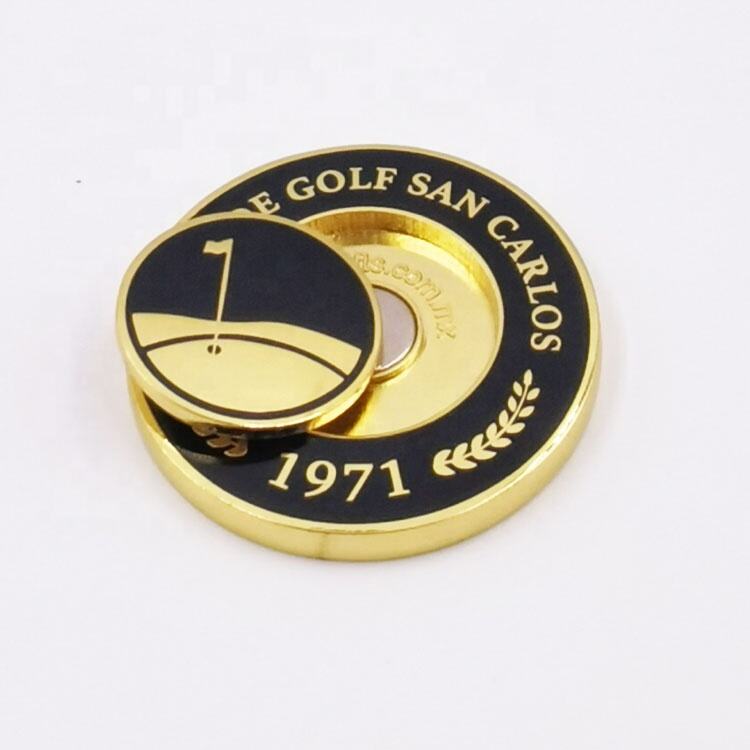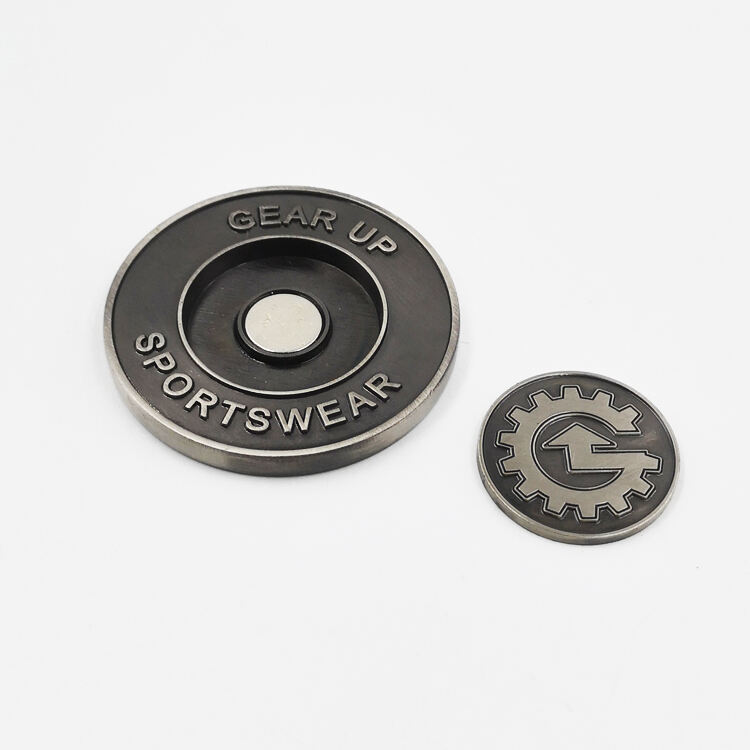The history of golf ball markers stretches back several centuries, evolving from humble beginnings into the sophisticated accessories we see on modern golf courses today. Understanding the development of these essential golf tools reveals fascinating insights into how the sport itself has transformed over time. From makeshift coins to precision-crafted custom designs, the golf ball marker has become an integral part of every golfer's equipment arsenal. The evolution of these small but crucial accessories mirrors the broader advancement of golf equipment technology and course etiquette standards. Today's golfers enjoy an unprecedented variety of options when selecting their preferred marking tools, each designed to serve both functional and aesthetic purposes on the green.
Early Origins and Traditional Practices
Ancient Marking Methods
The earliest forms of ball marking in golf can be traced back to the 16th century when golfers began developing methods to temporarily mark their ball positions during play. Before standardized rules existed, players used various objects found on the course, including small stones, twigs, or even damaged tees to indicate where their ball had landed. These primitive marking methods were often unreliable and sometimes led to disputes between players regarding exact ball placement. The lack of consistent marking practices created challenges for maintaining fair play and accurate scoring during competitive rounds.
Scottish golfers, who are credited with formalizing many aspects of the game, began establishing more systematic approaches to ball marking during the 17th century. They recognized the importance of precise ball placement for maintaining the integrity of the game, particularly when balls needed to be lifted for cleaning or when they interfered with other players' shots. This period marked the beginning of more organized thinking about golf accessories and their role in supporting proper gameplay mechanics.
Coin Usage Development
The transition to using coins as ball markers represents a significant milestone in golf history, occurring primarily during the 18th and early 19th centuries. Golfers discovered that coins provided several advantages over natural objects, including consistent size, weight, and visibility on the green. The flat profile of coins made them less likely to interfere with ball roll patterns, while their metallic composition ensured durability across multiple rounds of play. This practical innovation quickly spread throughout golf communities in Scotland and England.
Different denominations of coins became popular choices among various social classes of golfers, with wealthy players often using larger, more valuable coins as a display of status. The practice became so widespread that many golf clubs began incorporating specific coin-related rules into their local regulations. Some establishments even provided designated coins for use during club tournaments, ensuring uniformity and preventing potential disputes over marker size or appropriateness.
Standardization and Rule Development
Official Golf Organization Influence
The formation of official golf governing bodies during the 19th century brought increased attention to standardizing equipment regulations, including specifications for ball markers. The Royal and Ancient Golf Club of St Andrews, established in 1754, began developing comprehensive rules that addressed various aspects of equipment usage and course etiquette. These early regulations laid the groundwork for modern ball marker standards and helped establish consistent practices across different golf courses and regions.
As golf spread internationally throughout the 1800s, the need for universal standards became increasingly apparent. The United States Golf Association, founded in 1894, worked alongside international organizations to create cohesive rules that would apply regardless of geographic location. This collaborative effort resulted in specific guidelines regarding marker size, placement procedures, and acceptable materials, ensuring that golfers could participate in tournaments worldwide using familiar equipment and protocols.
Size and Material Specifications
The development of official size limitations for ball markers occurred gradually throughout the early 20th century, as golf organizations recognized the need to prevent markers from becoming putting aids or course obstacles. Initial regulations focused primarily on ensuring that markers remained small enough to avoid interfering with normal ball roll patterns while being large enough to remain visible to players and officials. These specifications typically limited marker diameter to approximately one inch, though exact measurements varied between different governing bodies.
Material restrictions evolved alongside size standards, with organizations establishing guidelines about acceptable substances for golf ball marker construction. Metal compositions became preferred due to their durability and weather resistance, while materials like wood or plastic were sometimes prohibited due to concerns about degradation or potential course damage. These regulations helped ensure that markers would maintain consistent performance characteristics across different environmental conditions and extended usage periods.

Modern Manufacturing and Design Innovation
Mass Production Techniques
The industrialization of golf equipment manufacturing during the mid-20th century revolutionized ball marker production, making high-quality markers accessible to golfers at all skill levels and economic backgrounds. Advanced stamping and molding techniques enabled manufacturers to produce consistent, precise markers in large quantities while maintaining strict quality control standards. This mass production capability significantly reduced costs and expanded the variety of designs available to consumers, fostering greater creativity in marker aesthetics and functionality.
Technological advances in metalworking and finishing processes allowed manufacturers to experiment with different alloys, surface treatments, and decorative elements. The introduction of computer-controlled manufacturing equipment ensured precise tolerances and consistent product quality across production runs. These improvements enabled the creation of more sophisticated marker designs while maintaining the affordability that made them accessible to recreational golfers and professional tournament players alike.
Customization and Personalization Trends
The rise of personalized golf accessories gained significant momentum during the latter half of the 20th century, as golfers sought ways to express individual style and commemorate special occasions through their equipment choices. Custom engraving technologies made it possible to add names, logos, dates, and decorative patterns to standard marker designs, creating unique pieces that reflected personal preferences and meaningful experiences. This customization trend expanded the emotional connection between golfers and their equipment while opening new market opportunities for manufacturers.
Corporate and promotional applications became increasingly popular as businesses recognized the marketing potential of custom golf accessories. Companies began commissioning branded ball markers for client gifts, tournament prizes, and employee recognition programs, creating a substantial secondary market for specialized designs. Golf courses and country clubs similarly embraced custom markers as merchandising opportunities and member amenities, further driving innovation in design capabilities and production techniques.
Contemporary Trends and Future Developments
Technology Integration
Recent technological developments have begun incorporating smart features and advanced materials into traditional ball marker designs, creating new possibilities for enhanced functionality and user experience. Some modern markers include magnetic attachments for convenient storage on golf caps or clothing, while others feature integrated tools such as divot repair functions or alignment aids. These multi-functional designs reflect the broader trend toward equipment consolidation and efficiency in modern golf gear.
Emerging technologies such as GPS tracking and digital connectivity are beginning to influence marker design concepts, though practical implementation remains limited by size constraints and cost considerations. Research into advanced materials continues to explore options for improved durability, weather resistance, and environmental sustainability. These developments suggest that future ball markers may incorporate features that extend beyond simple position marking to include performance analytics and course management capabilities.
Sustainability and Environmental Considerations
Growing environmental awareness within the golf industry has prompted increased attention to sustainable manufacturing practices and materials for ball marker production. Manufacturers are exploring recycled metals, biodegradable alternatives, and eco-friendly finishing processes to reduce environmental impact while maintaining product quality and performance standards. These initiatives reflect broader industry trends toward sustainability and responsible resource management in golf equipment manufacturing.
The development of environmentally conscious marker options has created new market segments focused on golfers who prioritize sustainability in their equipment choices. Some manufacturers now offer markers made from reclaimed materials or designed for end-of-life recycling, appealing to environmentally minded consumers. These products demonstrate that functional performance and environmental responsibility can coexist in modern golf accessory design, potentially influencing future industry standards and consumer expectations.
Cultural Impact and Collecting
Collectible Market Development
The emergence of ball marker collecting as a specialized hobby has created a vibrant secondary market for rare, vintage, and commemorative designs. Collectors seek markers from famous golf courses, major tournaments, and limited edition releases, often paying premium prices for items with historical significance or unique aesthetic appeal. This collecting culture has influenced manufacturer design decisions and created opportunities for specialized production runs targeting collector interests.
The collectible market has also preserved important examples of ball marker evolution, maintaining physical records of design trends and technological developments throughout golf history. Museums and private collections now house extensive arrays of markers representing different eras, materials, and manufacturing techniques. These collections serve as valuable resources for researchers studying golf equipment history and provide insights into broader cultural and technological trends affecting the sport.
Social and Ceremonial Uses
Beyond their practical function on the golf course, ball markers have acquired significant social and ceremonial importance in golf culture. Custom markers frequently serve as gifts for special occasions such as hole-in-one achievements, tournament victories, or retirement celebrations, creating lasting mementos of meaningful golf experiences. Wedding parties, corporate events, and charity tournaments often feature specially designed markers as participant keepsakes or fundraising items.
The tradition of exchanging ball markers between golfers has become an informal protocol for building relationships and showing mutual respect within golf communities. International golf travel has popularized the practice of collecting markers from courses visited during golf vacations, creating personal collections that document golfing adventures and experiences. These social aspects have elevated the ball marker beyond its utilitarian origins to become a symbol of golf culture and camaraderie.
FAQ
When were ball markers first officially regulated in golf
Official regulations for ball markers began developing in the late 19th and early 20th centuries as golf governing bodies established comprehensive equipment standards. The Royal and Ancient Golf Club of St Andrews and the United States Golf Association were instrumental in creating size and material specifications that remain largely unchanged today. These early regulations focused on preventing markers from interfering with play while ensuring consistent standards across different courses and tournaments.
What materials are commonly used for modern ball markers
Contemporary ball markers are typically manufactured from various metal alloys, including brass, stainless steel, aluminum, and zinc-based compositions. These materials offer excellent durability, weather resistance, and the ability to accept various finishing treatments such as plating, anodizing, or powder coating. Some specialty markers incorporate precious metals or alternative materials like ceramic or engineered plastics for specific aesthetic or performance characteristics.
How have ball marker designs evolved over time
Ball marker designs have progressed from simple coins and found objects to sophisticated, purpose-built accessories featuring custom graphics, multiple functions, and advanced materials. Early markers prioritized basic functionality, while modern versions often incorporate aesthetic elements, personalization options, and additional tools such as divot repair capabilities. This evolution reflects both technological advancement and the growing importance of personal expression in golf equipment choices.
Are there specific rules governing ball marker size and usage
Yes, golf's governing bodies maintain specific regulations regarding ball marker dimensions and usage procedures. Markers must be small enough to avoid interfering with ball roll but large enough to remain visible and functional. Official rules also specify proper placement techniques, including positioning the marker behind the ball before lifting and ensuring accurate ball replacement after marking. These regulations ensure fair play and consistency across all levels of competitive golf.




